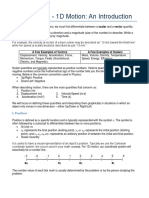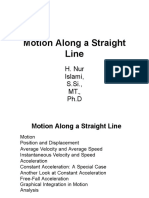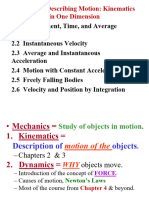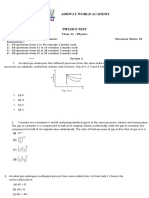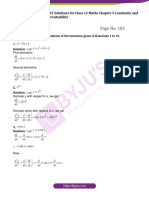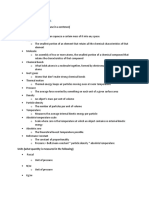CHAPTER 2: Motion in One Dimension
2.1 Position, Velocity, & Speed
Position - the location of the particle with respect to a chosen reference point that
we can consider to be the origin of a coordinate system.
Remember: The motion of a particle is completely known if the particle’s position in
space is known at all times.
Example:
Displacement – The particles’ change in position in some time interval. As the
particle moves from an initial position xi to a final position xf , its displacement is
given by
∆ x=x f −x i
Note: + ∆ x if x f > x i
−∆ x if x f < x i
Distance - the length of a path followed by a particle
Displacement Vs. Distance
If a player runs from his own team’s basket down the court to the other team’s
basket and then returns to his own basket, the displacement of the player during
this time interval is zero because he ended up at the same point as he started:
x f =x i so ∆ x=0. During this time interval, however, he moved through a distance of
twice the length of the basketball court.
Note:
Distance is always represented as a positive number
Displacement can be either positive or negative
vector quantity - requires the specification of both direction and magnitude
Vector Quantities:
displacement
position
�velocity
acceleration.
Remember : positive (+) and negative (-) signs are sometimes used to indicate
vector direction
scalar quantity - has a numerical value and no direction
Average velocity v x ,avg - defined as the particle’s displacement Dx divided by the
time interval Dt during which that displacement occurs:
∆x
v x ,avg =
∆t
the subscript x indicates motion along the x
axis
has dimensions of length divided by time
(L/T), or meters per second in SI units.
Important Notes:
The time interval ∆ t is always positive
If x f > x i then ∆ x and v x ,avg =∆ x /∆ t are positive
If x f < x i then ∆ x and v x ,avg =∆ x /∆ t are negative
Average speed v avg – a scalar quantity
- defined as the total distance d traveled divided by the total
time interval required to travel that distance:
d
v avg=
∆t
Facts about average speed:
SI unit of average speed is the same as the unit of average velocity: meters per
second
has no direction and is always expressed as a positive number
Pitfall Prevention:
Average Speed and Average Velocity
The magnitude of the average velocity is not the average speed. For example,
consider the marathon runner, the magnitude of her average velocity is zero, but
her average speed is clearly not zero.
Insert image of a runner
�2.2
